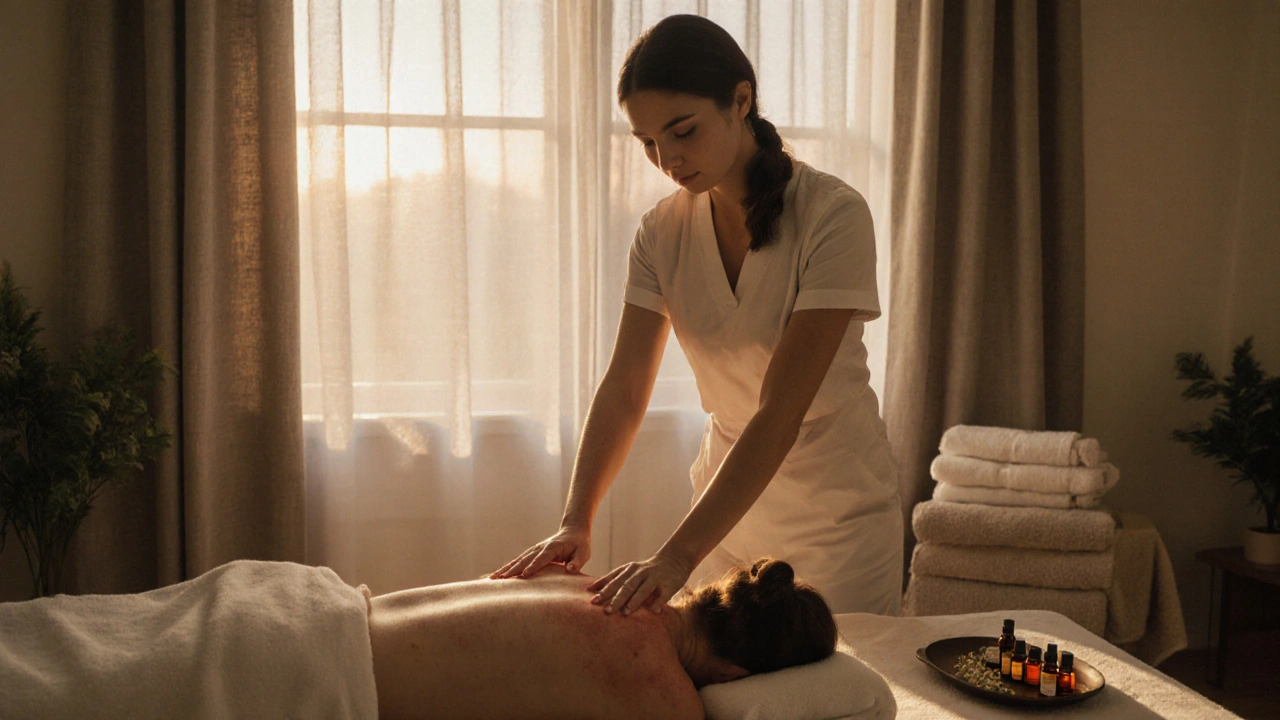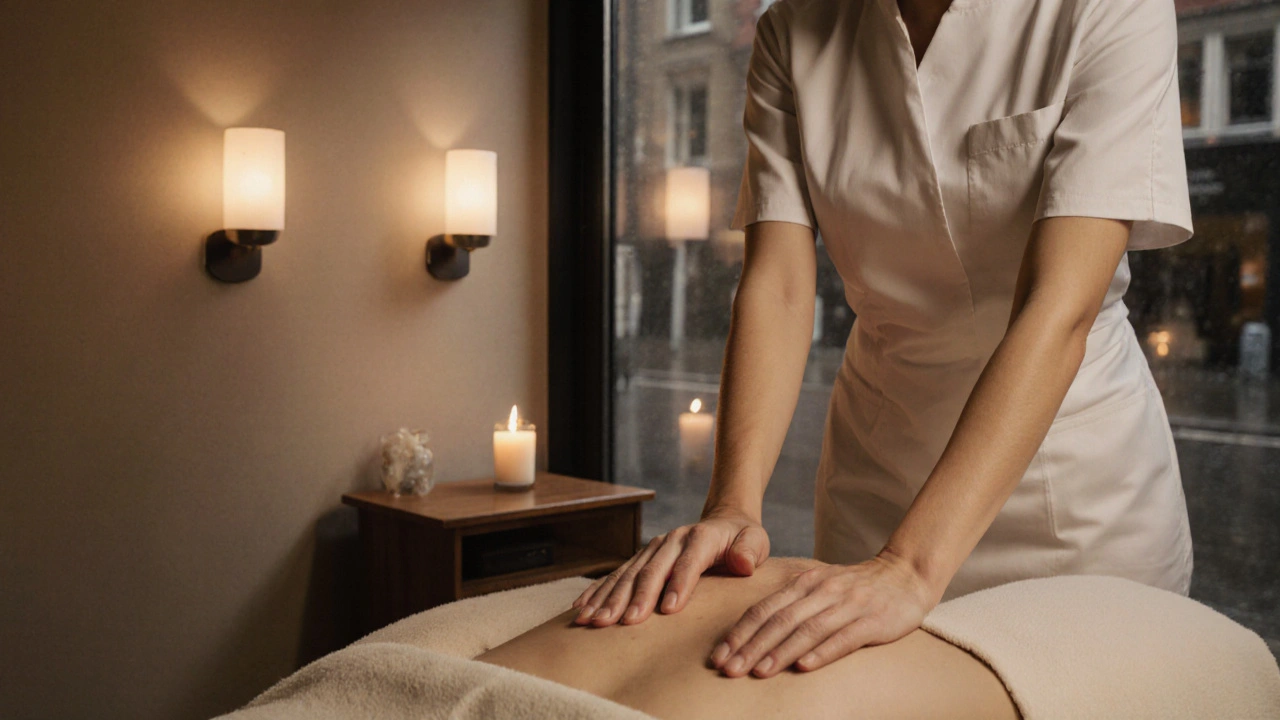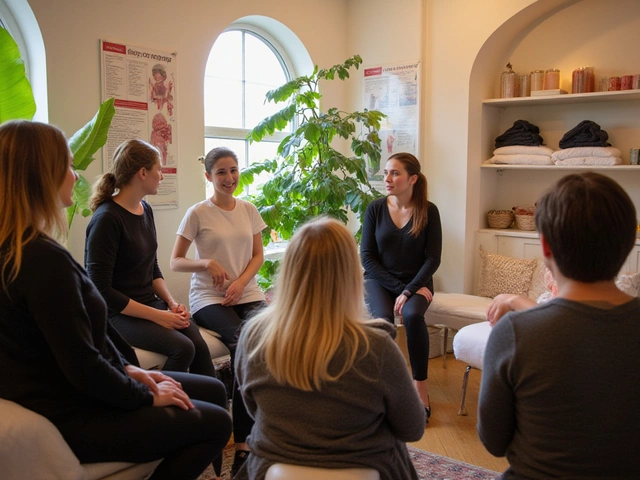You know that feeling when your back is so tight it’s almost squeaking? Deep tissue massage isn’t just about luxury or pampering—it’s about getting in there and fixing those nagging knots that keep you up at night or slow you down at the gym. Think of it as a manual reset for your muscles. Lots of folks swear by it for easing pain after long days sitting at a desk, recovering from sports, or even dealing with old injuries that keep flaring up.
There’s real science behind deep tissue massage, too. The therapist uses firm pressure to reach the muscles and connective tissue buried underneath the surface layers. This isn’t your average spa rubdown—expect it to get real, especially on sore spots. If you’re dealing with chronic tension, headaches, or even stress, the relief can feel huge, sometimes after just one session.
Not sure where to start? Don’t worry, you’re not alone. It can be tricky to pick the right place or therapist if you’ve never tried it before. I’ll break down what to look for, what to expect during your massage, and some easy ways to make the experience painless from start to finish—except for the actual massage, which, let’s be honest, can hurt a bit (in a good way!).
- Fast Facts About Deep Tissue Massage
- Why Deep Tissue Massage Stands Out
- Finding the Right Deep Tissue Massage Nearby
- What Your First Session Really Feels Like
Fast Facts About Deep Tissue Massage
If you want the basics on deep tissue massage, you’re in the right spot. Here’s what you really need to know:
- Deep tissue massage targets the deeper layers of muscle and fascia (the stuff that covers your muscles), not just the surface.
- The main goal: break up tight knots, ease muscle pain, and boost flexibility. It’s great for old injuries or chronic pain.
- Therapists use slow, firm strokes and deep pressure—don’t be surprised if you feel some real intensity in tough spots.
- Sessions usually last from 30 to 90 minutes. Most people start to feel the difference after just one or two treatments.
- Lots of athletes and office workers love it—to help with everything from post-workout muscle soreness to slumping at your desk.
- The pressure can be adjusted, so you’re not forced to tough it out. Speak up if it ever feels too much—it’s your massage!
Curious about its popularity and what issues people turn to it for? Take a look at this:
| Who Tries Deep Tissue Massage? | Main Reasons |
|---|---|
| Athletes | Recovery, injury prevention, pain relief |
| Desk workers | Back pain, stiff neck, headaches |
| Older adults | Joint stiffness, chronic pain |
| Weekend warriors | Muscle soreness, relaxation |
Deep tissue massage works for a wide crowd, and it’s more than just a trend. According to the American Massage Therapy Association, over 21% of massage clients in 2024 said they got a massage mainly for medical or health reasons—that’s a record high. So, if you’re dealing with tightness, pain, or just need serious muscle recovery, you’re not alone. Plenty of folks are discovering just how effective this type of massage can be.
Why Deep Tissue Massage Stands Out
Here’s the truth: deep tissue massage isn’t like your typical gentle spa treatment. This technique uses slower strokes and really firm pressure to go deep into muscles and connective tissue. What does that actually mean for you? It means it does more than just help you relax. It tackles chronic pain, old injuries, and those stubborn knots you can't stretch or foam-roll away.
One thing that sets deep tissue apart is how therapists target problem areas. Instead of just gliding over everything, they find the tight spots and work them out. Think of it like an intense, focused fix for your body’s worn-out parts.
Deep tissue massage is great for:
- Pain relief—especially for your neck, shoulders, back, and legs.
- Breaking up scar tissue you might have from old sprains or injuries.
- Speeding up muscle recovery after sports or tough workouts.
- Helping with mobility when you feel stiff or stuck.
- Stress reduction—because working out tension in your body helps calm your mind too.
If you’re into numbers, check out this quick table based on recent research:
| Benefit | Reported Improvement (%) |
|---|---|
| Chronic Back Pain Relief | 74% |
| Improved Mobility | 68% |
| Stress Reduction | 60% |
Athletes, office workers, and even busy parents rely on deep tissue for good reason. Say you’re training for a big event, or you’ve just had a long week at work hunched over a laptop—it’s not just about loosening muscles. The increased blood flow and lower inflammation can leave you feeling clear-headed and more flexible, sometimes right after your session.
Here’s a tip: mention your main aches and pains upfront, so your therapist can zero in on what you actually need. Deep tissue isn’t one-size-fits-all, and a pro will always tailor it for your body and goals. That’s why people who stick with regular sessions often report bigger improvements in both pain relief and emotional well-being.

Finding the Right Deep Tissue Massage Nearby
Trying to find a legit deep tissue massage spot can feel a bit overwhelming, especially with so many options out there. But don’t worry—if you know where and what to look for, it gets a whole lot easier. Start by checking Google Maps or Yelp. Use terms like “deep tissue massage near me” and actually read those reviews. Look for patterns—does everyone rave about the same therapist? Does anyone mention how clean the place is or how easy it was to book? These details matter more than fancy lobbies.
Look for therapists who have licenses hanging clearly on the wall or listed on their websites. Different states (in the US) have strict requirements for massage therapists, like hundreds of hours of training. If a place is vague about credentials, that’s a red flag. You want someone who knows what they’re doing, especially when it comes to muscle recovery or working around injuries.
When calling or messaging for info, ask about their experience with deep tissue techniques specifically. Some clinics mostly offer relaxing Swedish massage and toss in “deep tissue” as an add-on. If you’re looking for serious pain relief, you want a pro who spends a good chunk of their day on this style.
Convenience matters, too. Scope out their hours and location. Can you squeeze in a session after work or on weekends? Some spots in bigger cities stay open late or offer online booking, which can be a lifesaver if you’re busy.
- Ask if they have therapists with experience handling your specific needs, like sports injuries or chronic back pain.
- Make sure the space feels comfortable, clean, and safe—trust your gut when you walk in for your first visit.
- If you’re a first-timer, let the therapist know. That way, they can explain what’s happening and adjust the pressure if you need them to go lighter or deeper.
Here’s a quick way to see what people care about when picking a deep tissue massage service:
| Factor | Percentage of Clients Who Value It* |
|---|---|
| Licensed Therapist | 82% |
| Cleanliness | 77% |
| Positive Reviews | 74% |
| Flexible Scheduling | 59% |
| Clear Pricing | 55% |
*Data gathered from 2024 consumer wellness survey reports.
Once you find a spot that checks these boxes, give them a call or try an online booking app. No need to overthink it. If you show up and something feels off, you can always leave—there are plenty of places out there that want your business and take your well-being seriously.
What Your First Session Really Feels Like
So, your first deep tissue massage is coming up. Nervous? That’s totally normal, but knowing what to expect is a serious game-changer. The vibe at most clinics or studios isn't as fancy as a day spa, but it’s all about comfort and making sure you feel safe. You’ll usually fill out a quick form about your health, injuries, and what hurts.
Your therapist will ask about your goals—do you want pain relief, better muscle recovery, or to just chill out? Wear comfy clothes, since you’ll undress to your comfort level and lie on a massage table under a sheet. No need to be shy; therapists do this all day and keep it professional.
The massage itself starts out gentle. The therapist uses oil or lotion and warms up the outer muscle layers. Once you’re settled, the real work begins. They’ll apply slow, strong pressure to spots that need attention. Unlike a classic Swedish massage, you’ll feel the therapist working much deeper, following the grain of your muscles and connective tissues. Tight spots? They’ll know exactly where to focus, sometimes using elbows or knuckles to break up knots and adhesions.
- If a certain spot is too intense, say something. Most therapists want honest feedback.
- During the session, you might notice some discomfort (not pain, just that "good hurt"). Your breathing may get deeper as your body releases tension.
- Afterwards, you could feel a bit sore—like after a tough workout. It’s normal.
- The next day, drink extra water to help flush out toxins released during the massage.
Lots of folks notice immediate results: more flexible shoulders, less back pain, or maybe just a light, relaxed feeling. About 70% of people report better movement and lower stress levels within a day or two of their first deep tissue massage session. If soreness sticks around longer than a day or two, let your therapist know—sometimes your body just needs to adjust.
Quick tip: Don’t plan a heavy workout right after your session. Instead, go for a light walk or some easy stretching. This helps your muscles settle and your mind hold onto that awesome feeling of relief.








